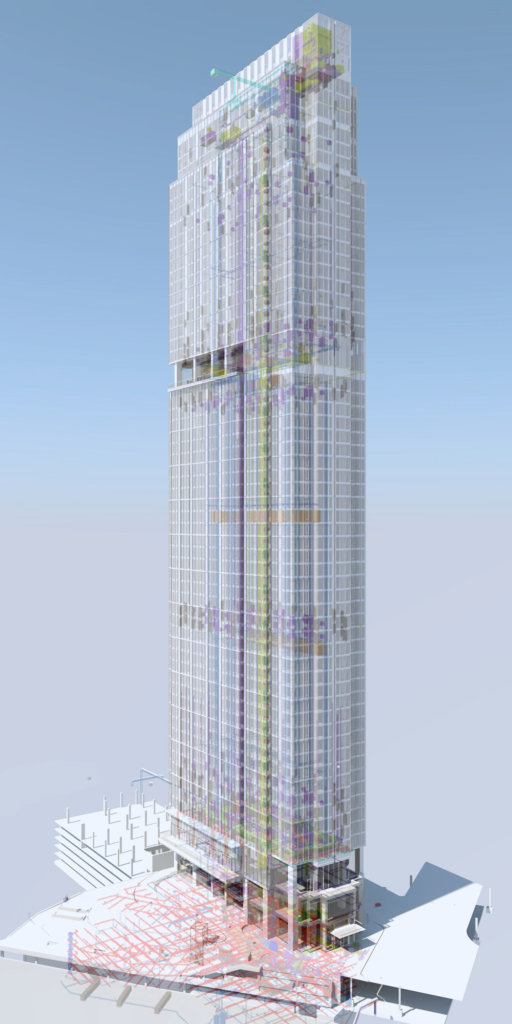Project Showcase
Wolf Point East
by Pappageorge Haymes Partners, USA
Wolf Point East rises 65-stories high above the convergence of the north and south branches of the Chicago River.
The luxury apartment tower features 698 residential units, high-end amenities located on several floors. The luxury apartment tower features 698 residential units, high-end amenities located on several floors. At its ground level, a four-acre riverfront park and ample retail space welcomes visitors.
Firm Name: Pappageorge Haymes Partners
Location: Chicago, USA
Type: Residential high-rise
Size: 65 stories
Software used: Archicad, BIMx, IFC
Coordinating across platforms using BIM
Completed in 2020, the Wolf Point East (WPE) project represented a major BIM coordination effort. Pappageorge Haymes Partners implemented Archicad – which supported their role as architect of record. Archicad enabled the team at Pappageorge Haymes Partners to oversee every aspect of the building as they worked with the developer, landowner, design architect, and general contractor.
Each consultant on the project used their chosen AEC technology, which meant Pappageorge Haymes Partners needed a powerhouse solution to manage coordination. Their solution of choice since the early 90s has been Archicad. For WPE, team members used Archicad to study and produce architectural conceptual presentations, permit and construction documents, as well as coordination of the project through all design phases.
We spoke to Peter Evanich, who was an integral part of the BIM coordination aspect of WPE. Evanich did have “a heavy hand” in the coordination aspect of this project, focusing on the unit plan drawings for the tower. “I drew every single unit (there are 698 of them) and every variation of those units. I was also managing coordination of the amenities, interiors, and documents that served the interiors firm.”

A 3-pronged approach to the design
WPE was unique for PH – in that the envelopes for each building comprising the tower were developed by another firm, Pelli Clarke Pelli, in another software solution. The model contained the skin of every building and general massing. That meant it was up to PH to coordinate everything on the inside of the east tower. PH relied on Industry Foundation Classes format (or IFC) to handle model exchange between Archicad and Revit, 2D drawings were exchanged via DWG and PDF files and Navisworks handled MEP coordination and clash detection.
“While Pelli Clarke Pelli maintained involvement in executing submittal reviews and processes directly related to the envelope itself; once the work transitioned into coordinating with structural, and MEP, as well as the contractors, we handled weekly meetings on the ground in Chicago, running the show as the local firm on the project.”
This project was almost entirely designed and modeled and drafted all in Archicad. PH executed concept design, massing, in Archicad. Occasionally a BIMx model was supplied to the contractor for on-site use, or the BIMx would be viewed on an iPad by an owner on site.

Tools for success:
Project Templates
Archicad served as a point from which PH pulled library details, as well as the project template to produce drawing sets and coordinated documents. Template use featured heavily in the coordination of WPE.
“It’s important to have an established project template across the board for every project that we do at Pappageorge Haymes,” explained Evanich. “We have a standardized template that our team members pull from for each new project. It impacts how we run projects, making the process cleaner and smoother, whether it is a townhome development or 60 story tower, larger residential buildings, and everything in between. The orderliness of starting with the template is key to our success on those projects.”

The orderliness of starting with the template is key to our success on those projects.
Peter Evanich
PH templates contain line types, colors, and has object favorites, wall type, favorites, slabs, columns; curated by a staff member. As the project evolves and application of layer combinations, layouts, views, etc… starting with the template provides us with a good foundation. Files remain clean and light while being accessible to periodic checks throughout the life cycle of the project to ensure optimal efficiency and performance of the model.
Templates are there to automate some of the process for Pappageorge Haymes Partners. The team there uses the project template and shared Archicad teamwork files in their server for accessibility. It contains a library of kitchens and bathrooms with the correct clearances built out. In this way, the team can be assured they are working to code on any project without having to recreate the wheel each time.
Tools for success:
IFC Coordination
Since adopting Archicad when Pappageorge Haymes Partners embraced BIM, the team has come to trust in it as the best BIM coordination tool available. Evanich and his colleagues continue to consider it to be the gold standard and the best at open BIM and IFC coordination on a Mac platform.
Dedicating the firm to a single software solution pays off when IFC coordination is needed because PH can deliver models rapidly and accurately on an extremely frequent basis. “Each project presents an opportunity to streamline the process. At times we are outputting an IFC file once a week or once every other week and deliver it to the contractors so that they can then incorporate it into their clash detection software with everybody else. Working in this way allows all parties to speed the process.”
Tools for success:
Implementation Plans
PH consistently looks for ways to apply lessons learned from each project. This can be said for WPE as well. Working within an established protocol PH developed a document in tandem with the contractor that became their execution plan.
“The execution plan served as a roadmap about how file transfers would work, what we need from the file, what we don’t. File naming conventions are covered as well as more important issues such as the level of detail needed for different aspects during phases of the design.”
… It absolutely was the most well-coordinated project to date at the time.
Peter Evanich
Evanich added that he’s seen how execution plans can even delineate which file types will be transferred, how to import them, export them, etc… putting it all on paper means there are fewer surprises.
“We leaned on our execution plan heavily during WPE. While it was not the first BIM complex project we had worked on – it absolutely was the most well-coordinated project to date at the time. Since then, the standard has been raised in the firm.”

Three decades of working with Archicad
The experience of working on WPE has bolstered confidence to continue relying on Archicad at the epicenter of all complex coordination projects. Archicad has evolved with the firm and the project type that they’ve been developing.
The firm began taking on more complex projects because Archicad was right there along the journey.
Peter Evanich
“Nearly three decades ago, Archicad fulfilled the need this firm had. As the demands for deliverables intensified in the AEC profession, such as what documents needed to be produced, 3D models needing to be produced, how intricate they needed to be for renderings, and so on, Archicad scaled to meet those needs. The firm began taking on more complex projects because Archicad was right there along the journey.”
About Pappageorge Haymes Partners
Pappageorge Haymes Partners has produced a remarkable and award-winning body of work that includes nearly every product and building type, from single-family homes to high-rises, expansive mixed-use developments, far-sighted neighborhood plans, and the creative adaptive re-use of structures across the United States.
Well known for the collaborative, client-oriented approach and insightful skill we bring to every project, PH is widely recognized as an important leader in its field. For more information visit pappageorgehaymes.com

